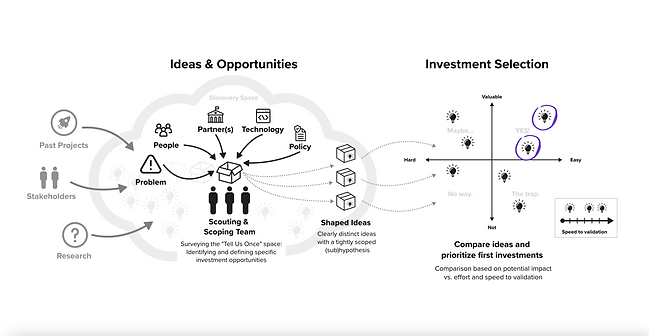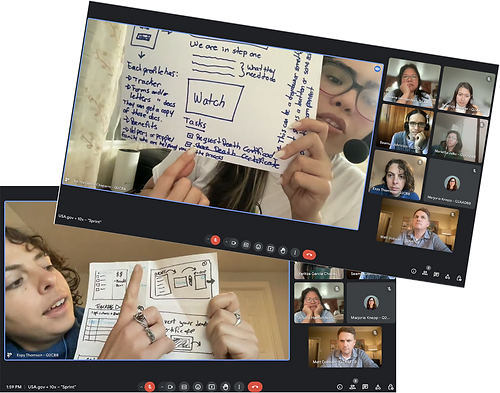
Tell Us Once
Streamlining Government Services through Data-Sharing
Overview
Problem
Every year, Americans waste billions of hours and dollars repeatedly providing the same information across government agencies. This redundancy creates frustration, erodes trust, and makes accessing essential services unnecessarily complex. In 2021, Executive Order 14058 aimed to improve the federal customer experience, but efforts focused on agency-specific fixes rather than seamless, cross-agency solutions. Without a unified approach, public interactions with the government remained fragmented and inefficient.
Approach
To tackle this challenge, I co-authored and served as a founding researcher, designer, and strategist for Tell Us Once, a first-of-its-kind investment portfolio within 10x, the federal venture studio. Inspired by international models like Estonia’s Once-Only principle, our goal was to design and prototype solutions that would enable people to share their information just once while accessing multiple services.
Impact
The portfolio project succeeded in identifying the necessary components for implementing a Once-Only approach in the United States Federal government, including a partner for the public-facing site where people would share their data, and the back-end technology needed to share data. The project has gathered ongoing support from senior leadership, changed 10x investment models and led to an early-stage product in partnership with USA.gov.
Role
Lead researcher,
product designer
Team
2 product managers, 1 researcher,
2 engineers.
Skills
Figma, UserTesting,
Lean Canvas methods
Agencies
10x Federal Incubator,
USA.gov
Process
Adding Structure
to Ambiguous Large Problems
As a government venture studio, 10x incrementally invests funding into ideas.
Our pitch secured initial funding to investigate the problem of sharing redundant information to the government, but that scope was still enormous.
We sought to narrow our work to a specific problem that we could build and scale a data-sharing service for.
Step 1.
Background research and ideation on top government data-sharing challenges for the public.

(Depiction of original idea selection process)
Step 2.
Evaluation and prioritization of investment opportunities.
Step 3.
Design discovery sprints on cross-functional teams with the public to determine if 1) we had identified a compelling problem and 2) if there was a data-sharing solution that would help the public.
Background Research
National and
International Context-Setting
We began by analyzing cross-agency application experiences in the U.S. and learning from international efforts in Estonia, the UK, and Canada. Through international workshops, stakeholder interviews, and discovery sprints, we identified over two dozen potential product ideas that could reduce redundant data collection. We prioritized solutions based on public impact, agency partnerships, and technical feasibility.
North Star
“Imagine a world in which online forms for interacting with governments are pre-completed with all the correct information or where governments automatically initiate services… without any forms or requests at all.“
Problem Space 1
Rethinking Death-Related Government Service Delivery
Inspired by the UK’s Tell Us Once service for death notifications, we hypothesized that simplifying government death reporting could significantly ease the burden on grieving families. My initial assumption, and pitch proposal, was that a single notification system could prevent families from reporting a death multiple times.
Assumption Testing
through
User Interviews
led to
A Pivot.
We discovered that the Social Security Administration already had an electronic death registration system that notifies multiple agencies when a person dies. The larger issue was not death notifications—but the time-consuming and complex survivor benefits application process. Families were forced to navigate multiple agencies, fill out redundant forms, and provide costly death certificates.
What I did next:
-
Conducted more interviews with next of kin who had recently lost a loved one.
-
Mapped the survivor benefits application process across multiple agencies.
-
Analyzed redundancy in death reporting and survivor benefit applications.
-
Developed and tested prototypes for a common survivor benefits application.
-
Conducted a technical discovery sprint using VA APIs for data-sharing.

Survivor Personas

Prototype Sketching
Survivor Benefits Application Prototype


Final Pivot: Death is a Dead End
My mapping exercise revealed that a "common survivor benefits application" could reduce duplicate form fields and data entry by 40%. However, further analysis showed that the number of underserved users was smaller than anticipated. Additionally, the most significant pain points for grieving families often involved handling affairs in the private sector—outside of our government mandate. Given these insights, we made a strategic decision to pivot the project, saving $175K in continued investment funds and focusing our efforts elsewhere.
Problem
Space 2
Developing USA.gov as a
Digital Door for Government Services
Americans already view USA.gov as the federal government’s “front door”, but USA.gov is only a content website that routes to other government sites. We partnered with the USA.gov team to explore personalized service offerings.
How might we reduce redundancy by allowing people to share their information just once with the government through USA.gov?
Through qualitative and quantitative research—including analyzing millions of user comments and USA.gov’s most-visited pages—we identified common life experiences where people repeatedly provide the same information across agencies.
One promising opportunity was name changes, which became the focus of a dedicated sprint (see Name Change Case Study). Additionally, we developed a strategic roadmap and technical blueprint for USA.gov, outlining the infrastructure investments needed to enable secure login, data privacy, and personalized services.

Problem
Space 3
X-Road Technical Discovery Sprint:
Building the Backend for Seamless Data-Sharing
A true Tell Us Once experience requires more than just a user-friendly front door—it demands secure, efficient data-sharing across agencies. We explored existing U.S. government data-sharing capabilities and studied X-Road, the privacy-first infrastructure that powers Estonia’s digital government.


We created a report and pitch materials for senior leadership advocating for an X-Road framework in the U.S., highlighting its ability to protect user privacy while enabling agencies to securely share data without centralizing it in a single system. This approach would not only improve efficiency but also reduce costs compared to traditional data centralization.
Reflection
Key Learnings and Next Steps
A government that delivers services in under two minutes—from application to approval—is possible. Countries like Estonia have proven it. However, in the U.S., fragmented data systems force people to repeatedly share the same information across agencies.
A Tell Us Once solution in the U.S. requires two key components—a digital front door (USA.gov) and a secure backend data-sharing system (X-Road). The challenge is massive, but our approach—focusing on a compelling, high-impact starting point—proved effective. Through market and business analysis, we identified name changes as the ideal entry point for scaling Tell Us Once (see Name Change Case Study).
Unfortunately, much of this work has been put on pause due to shifting priorities under the new administration (Trump/Vance). However, the research, prototypes, and technical roadmap remain valuable foundations for future modernization efforts.